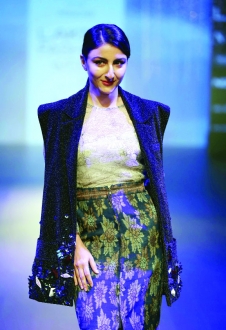The 2018 Lakme Fashion Week showcases different styles, including inter-woven material of cane along with metal and fabric, a marriage of digital technologies and textiles, and a fusion sari.
Young blood
Young fashion designers innovated on fabrics at the fashion week. Kanika Goyal’s look was all about adventure in fashion. Her fabrics were a mélange of various options as polyester cotton, viscose, 100 percent viscose, cotton silk, linen, poplin, rayon, bonded, acrylic, wool, cotton knit, silk organza, glass nylon, Dutch satin and PVC — all came seamlessly together with faux fur and leather.
Showstopper Soha Ali Khan looked stellar in a black sleeveless vest from Kanika Goyal, a sheer top from Poochki and a brocade pencil skirt from Shanti as a reinterpretation of floating clouds. A beautiful amalgamation of the texture, colours and shapes that resonated with nature. Making an impact on the runway was the printed navy and white floral cotton satin as well as Dutch satin mini with white silk organza over shirt.
When it came to garments that offer diversity contrast textures and construction then the Poochki label by Ishanee Mukherjee and Anirudh Chawla hit the high notes. Focussing on the style and cuts all the silhouettes were hand painted and block printed, to create a perfect combination of style, elegance and glamour. With a visually stunning story, black and electric blue were fused together with the signature binding, to cause a sensation on the ramp and crushed garments were used to depict volume. Belts were extensively used and tied into bows to give a very feminine appeal to each silhouette. With comfort being of primary preference, all the outfits were fluid and at the same time made a statement.
The designing pair Sakshi Shah and Swasti Shah’s label Shanti was a fashionable blend of hand woven pure silk and linen. The latter was beautifully indigo-dyed for a line of wearable creations. The stark line of the belted jackets was a perfect complement to the cropped pants. The angular single-button jacket with round-notched lapels gave the ankle length trousers a stylish twist. Giving the sari a 21st century appeal, the designing duo teamed it with calf length pants, a bustier and bolero. To match the theme Inspired by Clouds, the pair ensured that the handloom linen was indigo-dyed to create the textures of clouds. Goyal, Sakshi and Swasti of Shanti, Mukherjee and Chawla of Poochki, won The Platform award and showcased their collections based on smartwater’s core theme Inspired by Clouds.
Sustainable fashion
The designers showcased their Winter Festive collection on day 4 of Lakme Fashion Week. The collection, titled Raas was heavily inspired by Gujarat. In particular the signature prints like bandhani, patola and leheriya prints were reinterpreted and used in modern global silhouettes.
The designers were also inspired by the Kotwalia tribe of South Gujarat whose livelihood lies within cane basket weaving. They had inter-woven cane material with their signature thread work and metal strips to create an interesting surface texture. The fabrics used were mostly cotton silks, drill and flat chiffon. The chiffon and cotton silks were a reflective of the feminine side of the collection and the stiffer drill fabrics was a reflection of the sharper masculine side. Showstopper Shruti Hassan looked stunning in a beautiful soft and layered number in a nude palette.
Sari trouser
Label RmKV along with designer Sunita Shanker presented their latest collection Re-crafting Traditional Silks, for which Sushmita Sen was the showstopper. She wore a beautiful fusion-styled sari. The fuchsia sari was worn over a sleek pants that was matched with a sleeveless, corset blouse. Her make-up was neutral with red lips and thickly-lined eyes.
Sushmita Sen said in a press release, “RmKV epitomises my thoughts and the way I have lived my life. The collection showcases an exuberance in design, while maintaining a hold to values which I have been able to associate with all my life. With a sharp focus on sourcing sustainable material and incorporating it into their products, they constantly manage to show how they are changing the world of handloom silk. I am glad to be a part of a brand that encapsulates my thoughts and vision into theirs too.
Bringing fashion and tech together
Digital Empowerment Foundation (DEF) collaborated with three fashion designers who shared their concepts with the weavers who, in turn, translated them on to the warp and weft. They has been working for a decade to make underserved rural communities have access to equitable information. Digital Empowerment Foundation in partnership with various government bodies and CSR groups has initiated Digital Cluster Development Programme (DCDP), which primarily involves inclusive and decentralised use of Information Communication Technology (ICT) and other digital tools in critical aspects of handloom cluster development, especially improving and scaling up weaving skills, designs, marketing and entrepreneurship, besides creating sustainable livelihood options for the youth in the clusters.
The cotton weavers of Barabanki’s Project Baank-e-Loom runs from a 150-year old haveli in Saidanpur village that was constructed in the typical Awadhi style, surrounded by many traces of Nawabi culture. The village is home to around 50,000 weavers who make cotton gamchas. Arabi rumaal and stoles and are known for zari embroidery.
Another project, Digikala, started as a love of Ikat handlooms of Odisha. The project envisaged a marriage of hand woven textiles and digital technologies to enhance and expand the appeal of handloom products. The intention was to preserve the age-old tradition of Ikat weaving and empowering handloom weavers to sustain themselves in the competitive market. Ikat weaving is defined by the age-old tradition of intricate designs, tie-dye, and deep colours. While Barpali uses cotton, Naupatna uses Mulberry, Malda and Tussar silk.
Writer and Courtesy: The Pioneer








 OpinionExpress.In
OpinionExpress.In















Comments (0)